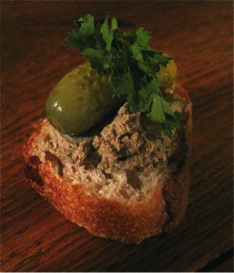
Making Elk Liver Pâté
Block title
 By: Ylva LekbergPh.D. Ecologist
By: Ylva LekbergPh.D. EcologistLast week, my husband shot his first elk on the ranch. It was close to sunset, and we had been stalking a herd of about 150 animals for some time. The scenery could not have been more spectacular. The Bitterroot Mountains were snow-capped across the valley, and sounds of cows mewing and young bulls sparring filled the air.
It was a good shot, and the bull died almost instantly. Neither of us took any joy in killing this beautiful animal, but we were grateful for the opportunity to fill our freezer with meat from an animal that had lived a free, wild life, far removed from the confinement and ritual slaughter that is the fate of most livestock. A bull elk can provide up to 200 lb. of butchered meat, and it was fascinating to learn what cut comes from which part of the animal. I was surprised how soft the hide was, and we decided to have it tanned so that this animal will both nourish us and keep us warm this coming winter. We left the antlers in the field, where they will provide calcium and other minerals to all the rodents who gnaw on them. The smorgasbord of entrails will nourish ranch-dwelling carnivores, such as coyotes, mountain lions, bears and wolves.
Photo by Alan Ramsey
I grew up eating liver pâté in Sweden and have vivid memories of my dad making it from pig livers. I figured I would give elk liver a try and was surprised how many recipes I found online. I decided on one that included onions and garlic, as well as Parmesan cheese, lemon zest and sherry (http://ohboykarencooks.blogspot.com/2011/11/antelope-liver-pate.html). The wonderful thing about liver pâté is that it is both great tasting and great for you. Because the liver is vital in detoxifying substances, there is a misconception that liver contains a lot of toxins. Nothing could not be further from the truth: liver pâté provides all the necessary B vitamins and an abundance of vitamin A, folic acid and iron. Who knew that this MPG Ranch elk would offer so many essential things?
I am eternally grateful to that elk for the sustenance it has provided us, and we will continue to learn how to make more and better use of all that wild game meat has to offer.


About the AuthorYlva Lekberg
Ylva graduated from the Swedish University of Agricultural Sciences with a M.Sc. in Biology and Horticulture in 1996 and a Ph.D. in Ecology from Penn State University in 2004. She received the Alumni Association Dissertation Award for her work in agroecology and subsistence farming in Sub-Saharan Africa. Post-doctoral positions at Montana State University and later at Copenhagen University as a Marie Curie Fellow allowed her to explore the role of arbuscular mycorrhiza, a root-fungus symbiosis, for geothermal plants in Yellowstone National Park and coastal grasslands in Denmark. Her research has been published in international journals such as Nature Communications, Ecology Letters, and New Phytologist.
Ylva joined MPG Ranch in 2010. Since then, she has explored how invasive plants common to western Montana, including spotted knapweed (Centaurea stoebe), leafy spurge (Euphorbia esula) and cheatgrass (Bromus tectorum), influence soil microbial community composition and function, and how this in turn may affect invasive success. A lot of her research also focuses on the AM symbiosis in terms of community ecology and physiology. A current project addresses how exchange ratios in this symbiosis may differ among co-occurring plants and depend on soil nutrient availabilities. She uses surveys, field and greenhouse experiments, and literature approaches such as meta-analyses to address questions. To learn more about research and publications from Ylva and her group, see CV below and the Soils, Plants and Invasion section.
In addition to her work at MPG Ranch, Ylva is an adjunct professor at University of Montana at the Department of Ecosystem and Conservation Sciences.
Ylva joined MPG Ranch in 2010. Since then, she has explored how invasive plants common to western Montana, including spotted knapweed (Centaurea stoebe), leafy spurge (Euphorbia esula) and cheatgrass (Bromus tectorum), influence soil microbial community composition and function, and how this in turn may affect invasive success. A lot of her research also focuses on the AM symbiosis in terms of community ecology and physiology. A current project addresses how exchange ratios in this symbiosis may differ among co-occurring plants and depend on soil nutrient availabilities. She uses surveys, field and greenhouse experiments, and literature approaches such as meta-analyses to address questions. To learn more about research and publications from Ylva and her group, see CV below and the Soils, Plants and Invasion section.
In addition to her work at MPG Ranch, Ylva is an adjunct professor at University of Montana at the Department of Ecosystem and Conservation Sciences.
Previous Dispatch:
How Does Fire Retardant Influence Arbuscular Mycorrhizal Fungi?




















